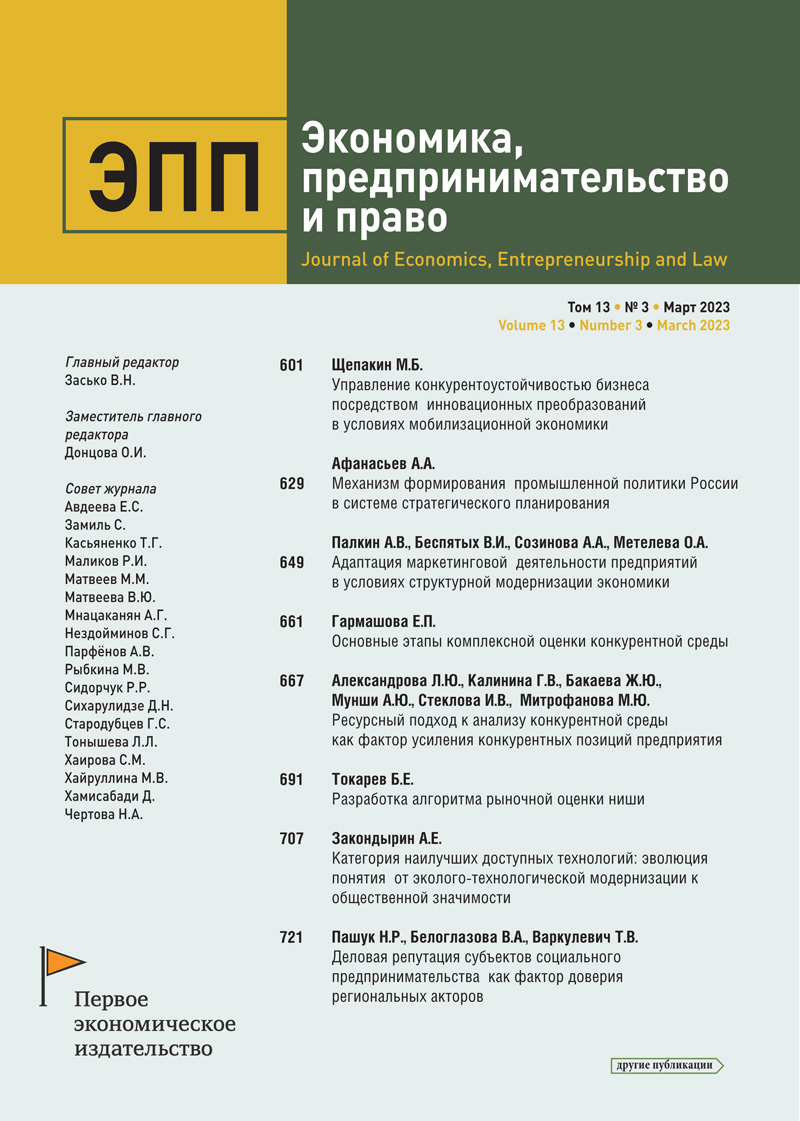Tools for creating an incentive system for the population to improve quality of life
- Authors: Ustinova O.E.1
-
Affiliations:
- The Financial University under the Government of the Russian Federation
- Issue: Vol 13, No 3 (2023)
- Pages: 929-940
- Section: Articles
- URL: https://journals.eco-vector.com/2222-534X/article/view/607693
- DOI: https://doi.org/10.18334/epp.13.3.117237
- ID: 607693
Cite item
Abstract
The problem of motivating the population to improve the quality of life and achieve well-being is one of the key ones. Its contributes to the sustainable development of the country. Considering that different social groups have their own ideas about the ways and forms of life, and the way of life depends on the existing motives for the activity of a particular individual, it is important to generalize the accumulated experience and determine the tools that form the motivation system of the population. The author analyzes of Russian households' disposable resources. Based on the considered approaches to the f motives of individuals, a set of tools for the formation of a system of motivation to improve the quality of life and achieve well-being is proposed. The results of the study may be useful to representatives of public authorities, public organizations, and private business.Funding.The article is based on the results of research carried out at the expense of budgetary funds under the state assignment of the Financial University under the Government of the Russian Federation.
Keywords
About the authors
Olga Evgenevna Ustinova
The Financial University under the Government of the Russian Federation
Email: olga.e.ustinova@yandex.ru
References
- Дудин М.Н. Общественно-политический дискурс, качество жизни и протестная активность населения // Экономические отношения. – 2022. – № 1. – c. 121-148. – doi: 10.18334/eo.12.1.114129.
- Городнова Н.В., Самарская Н.А. Повышение качества жизни граждан России в процессе реализации инновационных проектов // Вопросы инновационной экономики. – 2019. – № 3. – c. 721-734. – doi: 10.18334/vinec.9.3.40917.
- Нехода Е.В., Рощина И.В. Повышение устойчивости качества жизни: роль и вклад университетов // Креативная экономика. – 2019. – № 10. – c. 1873-1892. – doi: 10.18334/ce.13.10.41217.
- Федеральная служба государственной статистики. [Электронный ресурс]. URL: https://rosstat.gov.ru/folder/13397 (дата обращения: 30.01.2023).
- Bauer J. J., McAdams D. P. Eudaimonic growth: Narrative growth goals predict increases in ego development and subjective well-being three years later // Developmental Psychology. – 2010. – № 46. – p. 761–772.
- Belk R. W. Possessions and the extended self // Journal of Consumer Research. – 1988. – № 15(2). – p. 139–168.
- Deci, E. L., Ryan, R. M. (1991). A motivational approach to self: Integration in personality. In R. Dienstbier (Ed.), Nebraska symposium on motivation: Vol. 38. Perspectives on motivation (pp. 237–288). Lincoln, NE: University of Nebraska Press
- Deci E. L., Ryan R. M. Intrinsic motivation and self-determination in human behavior. - New York, NY: Plenum, 1985.
- Diener E., Suh E. M., Lucas R. E., Smith H. Subjective well-being: Three decades of progress // Psychological Bulletin. – 1999. – № 125. – p. 276–302.
- Hudders L., Pandelaere M. The silver lining of materialism: The effects of luxury consumption on subjective well-being // Journal of Happiness Studies. – 2012. – № 13(3). – p. 411–437.
- Hudders L., Pandelaere M. The silver lining of materialism: The effects of luxury consumption on subjective well-being // Journal of Happiness Studies. – 2012. – № 13(3). – p. 411–437.
- Huta V., Waterman A. S. Eudaimonia and its distinction from hedonia: Developing a classification and terminology for understanding conceptual and operational definitions // Journal of Happiness Studies. – 2014. – № 15(6). – p. 1425–1456.
- Kasser T., Ryan R. M. Further examining the American Dream: Differential correlates of intrinsic and extrinsic goals // Personality and Social Psychology Bulletin. – 1996. – № 22(3). – p. 280–287.
- Maslow A. Theory of Human Motivation // Psychological Review. – 1943. – № 50. – p. 370-396.
- McAdams, D. P. (2018). Art and science of personality development. The Guilford Press
- Richins M. L. The material values scale: Measurement properties and development of a short form // Journal of Consumer Research. – 2004. – № 31(1). – p. 209–219.
- Rogers, C. R. (1961). On becoming a person: A therapists view of psychotherapy. Houghton Mifflin
- Ryff C. D., Keyes C. L. The structure of psychological well-being revisited // Journal of Personality and Social Psychology. – 1995. – № 69. – p. 719–727.
- Ryff C. D., Dienberg Love G., Urry H. L., Muller D., Rosenkranz M. A., Friedman E. M. Psychological well-being and ill-being: Do they have distinct or mirrored biological correlates? // Psychotherapy and Psychosomatics. – 2006. – № 75. – p. 85–95.
- Steger M., Shin, J. Y. (2012). Happiness and meaning in a technological age: A psychological approach. In P. Brey, A. Briggle, E. Spence (Eds.), The good life in a technological age (pp. 92–108). Routledge
- Trading Economics. [Электронный ресурс]. URL: https://ru.tradingeconomics.com/european-union/indicators (дата обращения: 30.01.2023).
- Vallerand, R. J. (1997). Toward a hierarchical model of intrinsic and extrinsic motivation. In M. P. Zanna (Ed.), Advances in experimental social psychology (Vol. 29, pp. 271–360). San Diego, CA: Academic Press
Supplementary files









